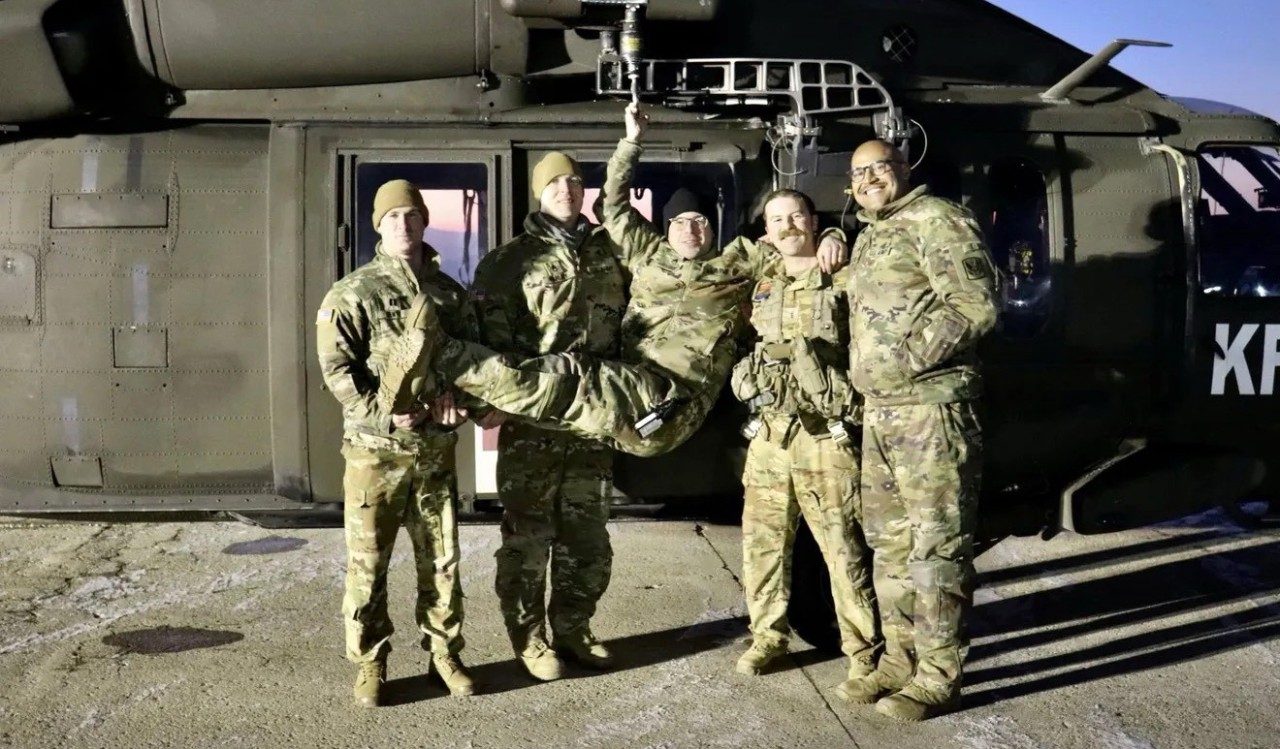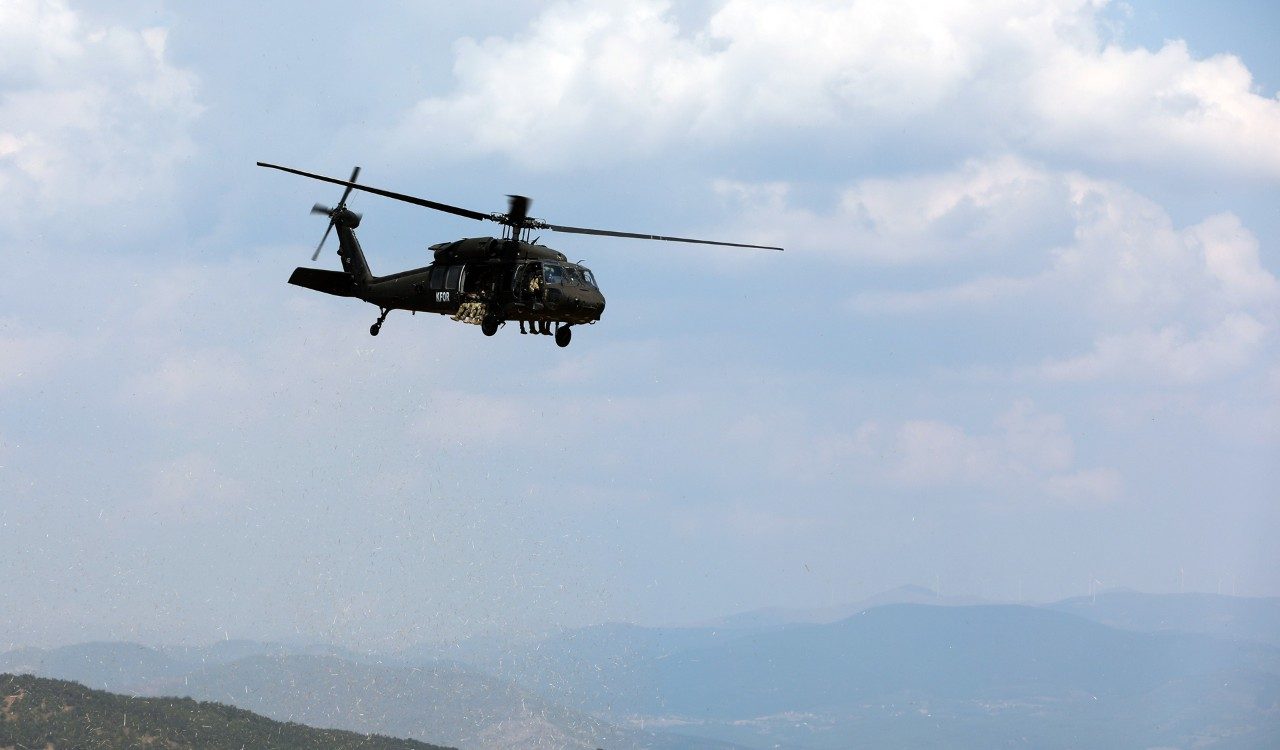Black Hawk Medevac Crew Rescues Tourists After Albanian Avalanche
During the middle of winter on Mount Korab in Albania, average temperatures can drop below 20 degrees Fahrenheit. Now imagine you’re stranded at 7,200 feet. You’ve been there for 48 hours, maybe even longer, and you’re in need of medical attention. You’re trying to survive freezing temperatures and high winds that are accompanied by valley fog into the overnight and morning hours.
These are the treacherous conditions two Swiss tourists faced before the Kosovo Force (KFOR) Medevac crew out of Camp Bondsteel answered the call with their Black Hawk on Jan. 22, 2024.
The crew of five deployed Rhode Island National Guardsmen responded to the rescue mission of seven Albanian military personnel, two Albanian police, and two injured Swiss tourists who were there skiing. The Albanian rescue personnel on the mountain were there to assist the tourists but made the call to KFOR when it was determined a helicopter was needed to get everyone off the mountain and the injured to medical care.
Responding to a call for help was nothing new for 20-year National Guard veteran, Chief Warrant Officer 3 Joshua Mason, and his crew. Each of them is a first responder in their civilian life. Not only does Mason have 10 years of flight experience, but he also started out in the military police when he enlisted in 2004.
“My pilot for this mission was a police officer as well. We had two police officers up front and three real-world paramedics in the back,” said Mason. “It’s been proven over the course of these last 20 years that National Guard units with all this real-world experience of severe trauma, day in and day out, pays off. So, everybody was in the right head space.”
What was new for this Black Hawk crew was flying in Albania. Mason and the crew relied on their high-altitude training experience earlier in the deployment and previous mountainous terrain training in Colorado.
Flying at altitude is often challenging for helicopters, as the thinner air and higher winds can make it difficult to generate stable lift. The Black Hawk is designed for safe and reliable operations at higher altitudes, with wide chord rotor blades and a powerful T701 engine.

The Kosovo Force 1st up Medevac crew celebrates a successful medevac operation. From left to right, Capt. Mark Dente, Staff Sgt. Ryan Farley, Staff Sgt. Matthew Medeiros, Chief Warrant Officer 3 Joshua Mason, and Sgt. Brandon Bessette (Photo courtesy Rhode Island National Guard).
Mission Planning and Coordination
Mason, the pilot in command, received the call to support the Albanian Ministry of Defense with the search and rescue near to Kosovo border. Initially, it was reported that seven patients and possibly one deceased individual were stranded at a high altitude in unpassable terrain. Their exact conditions were not known, but the crew took the information they had and began to coordinate a plan. Here is how they prepared:
- Moved the UH-60L Black Hawk aircraft out of the hangar and got it ready for launch. Due to the freezing temperatures and fog, the aircraft was hangered which was not the norm because it added to their response time. In the last three weeks of deployment, the crew found themselves with the last dedicated Medevac aircraft left at Camp Bondsteel, capable of carrying out this kind of hoist mission.
- Determined there would not be enough fuel to complete the mission, about 30 minutes away. So, they identified Tirana International Airport, just north of the hospital, as their refuel location.
- Gathered extra heating pads, blankets, and additional medical supplies to leave on the ground, in case multiples trips were needed.
Staff Sgt. Matthew Medeiros was the flight medic with over 13 years of ground and flight medic experience in the military. Despite his extensive experience, he decided the mission would be well served with an additional medic aboard to treat the wounded, Staff Sgt. Ryan Farley.
“There's going to be a lot of quick decisions. There’s a lot of experience in the aircraft, which is great, but knowing a lot of these things before we take off, when last minute things happen, it just makes those decisions a lot easier and makes everybody a lot safer,” said Medeiros.
Ground Operations and Patient Extraction
When arriving on scene, the crew saw 11 people on the ground and fresh fallen snow which meant an avalanche most likely occurred. Medeiros was hoisted down and the aircraft waited a short distance away. Good news then came from Medeiros that everyone was alive, and the two civilian patients required medical attention. The other nine people were the Albania rescue personnel who requested to be hoisted off the mountain because they were unsure if they would be able to make it off on their own.
Due to the amount of fuel remaining, the crew decided to transport the injured patients first, refuel, and then return to pick up the rescue personnel. The crew hoisted the patients on board and the medics began treatment. By the time the aircraft arrived at the hospital, reporters and about 100 people were waiting for them as the patients were offloaded to receive care.
The crew re-fueled at Tirana Airport. With sunset in less than two hours, the crew did not feel comfortable leaving the remaining nine people on the mountain for another night. Four of them were able to hike out on their own and the other five were hoisted and dropped off by their snowmobile.
After four hours, the mission was complete, everyone was rescued from the mountain and the crew returned to base.

The Rhode Island National Guard 1-126th Aviation Regiment was deployed in Kosovo for 10 months where they served in support of Operation Joint Guardian, a NATO peacekeeping mission (U.S. Army National Guard photo by Capt. Alexandra Curtis).
Built to Support the Mission
During the mission, the KFOR crew was supported by a UH-60L Black Hawk to deliver the performance required to safely rescue the stranded individuals from harsh weather conditions. The aircraft’s hoist capabilities enabled the crew to remove the injured from mountainous terrain where landing was not possible. With a cruise speed of 155 kts, the crew was able to reach the mountain as soon as possible.
“Based on our performance planning card, we flew at our max range airspeed,” said Mason. “I knew fuel would become an issue so we wanted to get as much out of the aircraft that we could.”




